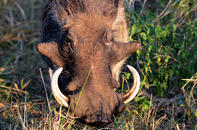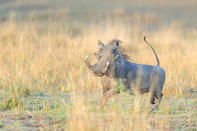Tusk Defense
A warthog’s tusks are formidable defence weapons. They are modified canine teeth that grow sideways out of the warthog’s mouth and the upper tusk can reach lengths of about 60 cm and the lower about 13 cm.

Although the lower tusks are the smaller ones, these are the ones that can cause serious injury to unwary enemies. The lower tusks articulate against the inner groove of the upper tusks and each time the warthog’s mouth opens or closes, the lower tusks are sharpened and become blade-sharp. The upper tusks of old females curl over the snout more than in males.
When fleeing danger, warthogs erect their tails which comically look like navigational aerials. This action is, in fact, an involuntary muscular reaction activated when the pigs take fright and run away. The tail acts as a ‘follow me’ sign to the piglets and other members of the sounder especially necessary when running through tall grass.
Diurnal and Silent

Warthogs are highly diurnal meaning they are only active during the day and they will retreat into holes - usually the disused excavations of aardvark - before nightfall. On cold, wet or overcast days, warthogs come out of their burrows much later than usual.
The more stable micro-climate inside the burrow affords their naked bodies critical protection from the weather conditions. They will also use burrows for shade during the extreme heat of summer middays. Warthogs are generally silent animals but they do grunt and snort to keep contact with the group or if aggressive.
Piglets squeak if under stress. By far the most amusing sounds made by warthogs are the jaw-chomping noises produced by a boar courting a sow. These sounds can be heard 50 m away from the mating couple.
By Megan Emmett